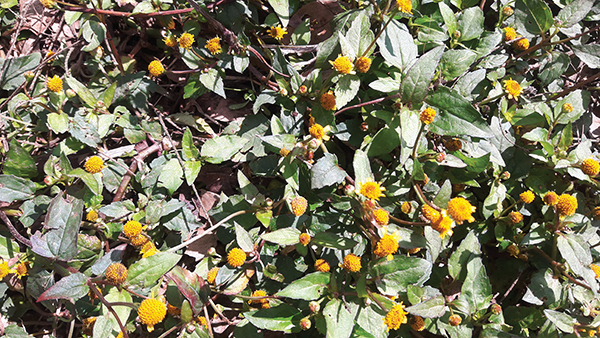Aakaarkarabh ( Acmella oleracia)
This plant is known as akarkara in Hindi and commonly known as toothache plant or electric daisy in English. It belongs to family Asteraceae. It’s description is not found in the ancient Ayurvedic books. References about akarkara start from medieval Ayurvedic books like Bhavprakash and Gadnigraha. Origin of this plant is not clear but it seems to be derived from Brajilian acmella species. Another species of it is known as Anacyclus pyrethrum originated from Arab countries.
Plant description: It is a perennial erect or stout herb 20 to 50 cm high. Leaves are opposite, petiolate, broadly ovate, narrowed at base, acute or obtuse at apex. The flowers are conical, axillary or terminal in loose branching clusters. These are yellow at the center and white rays of petals by its sides. The flower bud has a grassy taste followed by a strong tingling or numbing sensation and often excessive salivation, with a cooling sensation in the throat so known as “electric buttons.” In India, they are used as flavoring in chewing tobacco. The root is almost cylindrical, very slightly twisted and tapering and often crowned with a tuft of grey hairs. Externally it is brown and wrinkled, with bright black spots. It has many oleoresin glands. The taste is pungent and odor slight. This plant prefers well-drained, black high organic content soil. Seeds need direct sunlight to germinate, so should not be buried in soil.
Ayurvedic pharmacology: Guna- Ruksha, Teekshna Rasa- Katu Vipaak- Katu Veerya- Ushna
Chemical composition: It has shown a brown, resinous, acrid substance containing pelletonin, two oils—one dark brown and acrid, the other yellow, tannin, gum, potassium sulphate and carbonate, potassium chloride, calcium phosphate and carbonate, silica, alumina, lignin. An alkaloid pyrethrine yielding pyrethric acid is stated to be the active principle.
Therapeutically useful parts: Flower, leaf, root and whole plant.
Therapeutic uses: The flower heads are chewed to relieve toothache and other mouth related troubles. Leaves are used externally in treatment of skin diseases. Root decoction is used as purgative. Leaf decoction is used as diuretic and lithotriptic. Whole plant is used in treatment of dysentery. Akarkara root is widely used because of its pungent efficacy in relieving toothache and in promoting a free flow of saliva. The tincture made from the dried root may be applied to relieve the aching of a decayed tooth. It can be rubbed on the gums for pyorrhoea. The powdered root forms a good snuff to cure chronic catarrh and to clear the sinuses by stimulating free flow of nasal mucous and tears. It is also used in the medicines of premature ejaculation.
Doses: 500 mg to 1 gram.
Dr. Pratibha Mamgain, Department of Ayurvedic Medicine

